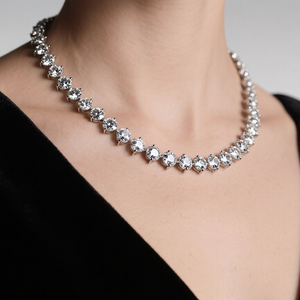Solid Gold vs. Gold-Plated vs. Gold-Filled: Unraveling Jewelry Mysteries
In the glittering world of jewelry, solid gold, gold-plated, and gold-filled pieces often leave shoppers scratching their heads. At first glance, they might shine similarly, but dig deeper, and you’ll find huge differences in value, durability, and care needs. Today, we’re demystifying these three types to help you shop smarter and pick pieces that fit your lifestyle.
Solid Gold: Timeless Dignity & Value Retention
True to its name, solid gold refers to jewelry with an extremely high gold content. Internationally, it’s typically defined as 24K gold, boasting a gold purity of over 99.9%. This high purity gives solid gold unique physical and chemical traits that set it apart.
Physical Properties
Solid gold is soft and highly ductile, making it a dream for artisans. It can be shaped into intricate designs—from delicate filigree to bold statement pieces—with ease. However, this softness is a double-edged sword: solid gold jewelry is prone to bending, scratching, or deformation with daily wear, so extra care is a must.
Chemical Properties
Gold is chemically stable, meaning it resists corrosion and oxidation. Even after years of wear, it retains its warm, bright luster without discoloring.
The Big Advantage
Solid gold’s greatest strength is its ability to hold (and often grow) in value. As a timeless “hard currency,” gold has symbolized wealth for centuries. While its market value fluctuates, it generally maintains strong value retention, making it a top choice for investment or heirloom pieces. The tradeoff? Solid gold jewelry comes with a higher price tag, which can give some shoppers pause.
Gold-Plated: Affordable Fashion for Everyday
Gold-plated jewelry is created by electroplating a thin layer of gold onto a base metal (think copper, silver, or zinc). The gold layer here is ultra-thin—usually between 0.1 microns and 2 microns thick.
Standout Features
The biggest draw of gold-plated pieces is their eye-catching appearance. They mimic the golden glow of solid gold, letting you rock that luxe look without the luxury price tag. Since the base metal is inexpensive and the plating process is cost-effective, these pieces are budget-friendly and offer great value for casual wear.
The Catch
That thin gold layer is also their downfall. With daily friction, bumps, or exposure to moisture/chemicals (like perfume or lotion), the gold plating can wear away or chip. Once the base metal peeks through, the jewelry loses its shine—and worse, the underlying metal might cause skin irritation, especially for those with sensitive skin.
Value Note
Gold-plated jewelry has little to no value retention. Its worth lies in its design and style, not the tiny amount of gold used, so it’s not an investment—just a fun, disposable fashion accessory.
Gold-Filled: The Sweet Spot for Durability & Value
Gold-filled (also called rolled gold) is made by mechanically bonding a thicker layer of gold foil to a base metal core through rolling. The gold layer here is significantly thicker than plating—usually 10 microns to 50 microns—creating a strong, long-lasting bond.
Why It Shines
Compared to gold-plated pieces, gold-filled jewelry’s thicker gold layer makes it far more durable and wear-resistant. With proper care (avoiding harsh chemicals, removing before swimming/showering), it can retain its color and finish for years, with minimal risk of the gold layer peeling or wearing off.
Price Point
Gold-filled jewelry lands somewhere between solid gold and gold-plated options. It offers that coveted gold texture and shine but at a fraction of solid gold’s cost. For shoppers who want quality that lasts but don’t want to splurge on solid gold, it’s a fantastic middle ground.
Value Reality
While gold-filled jewelry holds more value than gold-plated pieces, it still can’t compete with solid gold for long-term value retention. Its worth depends on factors like the thickness of the gold layer, craftsmanship, and the quality of the base metal.
How to Tell Them Apart & Choose Wisely
Wondering how to spot the difference when shopping? Here are a few handy tips:
- Check the Marks: Jewelry often comes with stamps that reveal its type. Solid gold may be marked “24K,” “Au999,” or “Gold 999.” Gold-plated pieces might have “GP” (Gold Plated) or “KP” (Karat Plated). Gold-filled jewelry is typically stamped “GF” (Gold Filled) or “RGP” (Rolled Gold Plate).
- Feel the Weight: Thanks to gold’s high density, solid gold jewelry will feel noticeably heavier than gold-plated or gold-filled pieces of the same size.
- Professional Testing: For absolute certainty, take the piece to a professional jewelry tester or lab—they can verify the gold content and type with precision.
Choosing What’s Right for You
- For Investment/Heirlooms: Go with solid gold. Its value retention and timeless appeal make it ideal for pieces you want to pass down or grow in worth.
- For Daily Fashion Fun: Opt for gold-plated. It’s affordable, comes in endless styles, and you won’t stress about replacing it when trends change.
- For Durable, Everyday Wear: Gold-filled is your best bet. It balances longevity, shine, and cost, perfect for pieces you’ll wear regularly.
Final Thoughts
Understanding the differences between solid gold, gold-plated, and gold-filled jewelry takes the guesswork out of shopping. Whether you’re hunting for an investment piece, a trendy accessory, or something durable for daily wear, knowing their pros and cons helps you pick jewelry that fits your needs and budget. Happy shopping! 💍✨
Sample Product Widget























